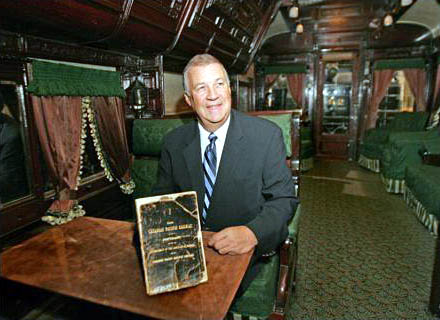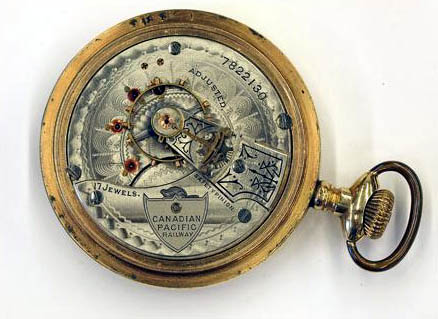|
2009 |
 |
 25 September 2009 Our "National Dream"  Exporail president Stephen Cheasley holds R.B. Angus's copy of the 1881 "national dream" contract that led to the building of the transcontinental railway, completed in 1885. He is sitting in Sir William Van Horne's private railway car, the Saskatchewan, now part of Exporail's permanent exposition.  St. Constant Quebec - Ten days before he died in 2007, Fred Angus
of Westmount told Exporail, the Canadian railway museum on the South Shore of Montreal, about an important document that he wanted to
bequeath.
St. Constant Quebec - Ten days before he died in 2007, Fred Angus
of Westmount told Exporail, the Canadian railway museum on the South Shore of Montreal, about an important document that he wanted to
bequeath.
It was his The contract set out to fulfill what has become known in Canadian history as the "National Dream" - a transcontinental railway to unify the sparsely populated country. Canada had been born in 1867 as a result of the British North America Act. But to get British Columbia to join Confederation as the sixth province in 1871, an amendement to the BNA Act entrenched a federal promise to B.C. to create a transcontinental rail link. Construction of that link was completed as a result of an 1881 contract between the federal government and the seven members of the new Canadian Pacific Railway syndicate.  Canadian Pacific Railway pocket Watch, 1892: The introduction of standard time by a Canadian, Sir Sandford Fleming, laid the foundation for the depature and arrival schedules of railway companies across different time zones. The Canadian Pacific Railway had its own corporate line of pocket watches, manufactured by the Waltham Watch Company. Photographs in the early 1900s would frequently depict a train engineer and conductor standing looking at their pocket watches, showing that their employer ran an efficient railway. The watch shown here was bequeathed by the estate of Fred Angus of Westmount. Then, as now, parties to contracts were entitled to their own original copies. As one of seven original investment partners in the CPR syndicate, and one of four original company directors, R.B. Angus received his own handsome leatherbound copy. This copy, the same one that Fred Angus told Exporail president Stephen Cheasley about, is the only original copy known to exist today. Now this copy is part of the museum's temporary exposition titled "What's In The Box?" The exposition, which runs at Exporail until The title refers to the many precious items that were mailed to the museum in little boxes, sent by people carrying out the wishes of the recently deceased. The Angus name, of course, needs no introduction to Montrealers. The former Angus rail yards in Rosemont were an important part of Montreal's history through the 20th century. Fred Angus, editor of Canadian Rail Magazine for 26 years, bequeathed many rare items to Exporail, including old Bank of Montreal $20 notes bearing R.B.'s likeness. But nothing compares with R.B.'s copy of the "National Dream" contract in terms of historical importance, says Cheasley. "Since there were seven members of the CPR syndicate, along with the government of Canada, there were probably only a dozen or so original copies of the contract," he said. "But we don't know whether there are other bound copies still in existence. I would think there must be a copy somewhere in the national archives in Ottawa. But we don't know of any others." The government of Sir John A. Macdonald promised British Columbia in 1871 to build the railway within 10 years. But little progress had been made by 1881 and, as a result, a separatist movement arose in B.C. In response, the federal government signed a new deal in 1881, with the newly incorporated CPR group, to build the railway by 1891. The CPR finished the job within five years. On In Alexander Ross's photograph of Smith's driving home the Last Spike, said to be the most important photograph in Canadian history, Sir William Van Horne, the CPR's chief executive, can be seen on Smith's immediate right. Van Horne had travelled from Montreal to B.C. for the ceremony in his private railway car, the Saskatchewan. Today, that car is part of the permanent exposition at Exporail. Exporail's permanent collection, as well as exhibits featured in "What's in the Box?", are a reminder of the vital role that the railroad played in Canadian If You Go Exporail is situated at 110 St. Pierre St. in the South Shore suburb of St. Constant. To get there from Montreal, take the Champlain or Mercier Bridge and Route 132 to St. Constant. In St. Constant, turn south on Route 209 and follow the blue tourist signs for Exporail. Exporail is open from 10 a.m. to 5 p.m., Wednesday through Sunday, until 1 Nov 2009. From Special holiday hours are in effect at Christmas and during spring break. Admission is $16 for adults, $13 for seniors, $10 for children age 13 to 17, and $7 for children age 4 to 12. A family pass for two adults and two children age 4 to 12 costs $39. For more information, call David Johnston. |
|
OKthePK Vancouver Island British Columbia Canada -
http://www.OKthePK.ca/ |